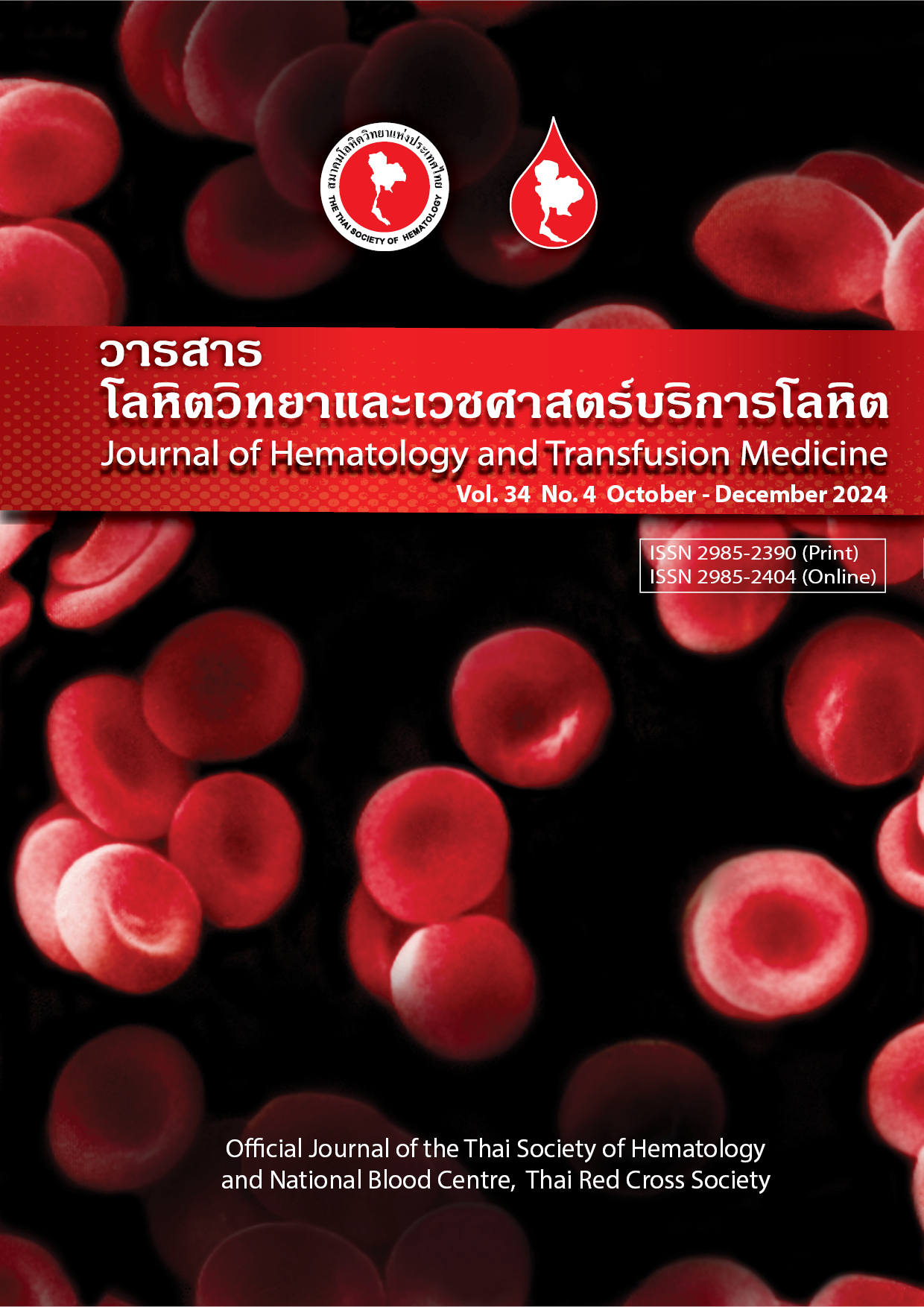The Anaplastic large cell lymphoma with concomitant Hemophagocytic Lymphohistiocytosis (HLH): hyperinflammation and capillary leakage syndrome
DOI:
https://doi.org/10.69898/jhtm.v34.2024.271013Keywords:
Anaplastic large cell lymphoma, hyperinflammatory state, malignancy-associated hemophagocytic lymphohistiocytosis, capillary leakage syndrome, Histiocytotic syndromeAbstract
In our 19 years’ experience at King Chulalongkorn Memorial Hospital, we were able to observe 21 pediatric cases with anaplastic large cell lymphoma (ALCL). Of these 21 cases, 4 (19% of ALCL cases) had concurrent hemophagocytic lymphohistiocytosis (HLH). All developed fever, lymphadenopathy and exaggerated signs of capillary leakage syndrome such as generalized edema, pleural effusion or ascites. The hyperinflammation was demonstrated with fever, hypoalbuminemia and elevated inflammatory markers. A high index of suspicion is warranted to recognize concurrent HLH when patients develop cytopenia, splenomegaly, liver dysfunction and pleural or pericardial effusions. For HLH with unknown etiology but with lymphadenopathy, lymph node biopsy should be considered as a part of secondary HLH workup to rule out malignant-associated hemophagocytic syndrome. Treatment with lymphoma-directed therapy should not be contraindicated once a diagnosis of ALCL is made. Instead, one should be cautious whenever a hyperinflammatory state and multi-organ dysfunction exists because HLH-sensitive agents such as corticosteroid, etoposide, cyclosporin A, cyclophosphamide, IVIG and others should be urgently administrated. The mortality was quite high (50%) in our institution. Initial treatment with HLH protocol saved the lives of the other 2 patients (50%), both of whom were cured later with lymphoma-directed protocol.
Downloads
References
Swerdlow SH, Campo E, Pileri SA, Harris NL, Stein H, Siebert R, et al. The 2016 revision of the World Health Organization classification of lymphoid neoplasms. Blood. 2016;127:2375-90.
Mellgren K, Hedegaard CJ, Schmiegelow K, Muller K. Plasma cytokine profiles at diagnosis in pediatric patients with non-hodgkin lymphoma. J Pediatr Hematol Oncol. 2012;34:271-5.
Lehmberg K, Sprekels B, Nichols KE, Woessmann W, Muller I, Suttorp M, et al. Malignancy-associated haemophagocytic lymphohistiocytosis in children and adolescents. Br J Haematol. 2015;170:539-49.
Ponnatt TS, Lilley CM, Mirza KM. Hemophagocytic Lymphohistiocytosis. Arch Pathol Lab Med. 2022;146:507-19.
Chen SH, Chen JS, Jou ST, Wu KH, Hung IJ, Sheen JM, et al. Outcome and prognosis of anaplastic large cell lymphoma in children: a report from the Taiwan Pediatric Oncology Group. Leuk Lymphoma. 2019;60:1942-9.
Brennan AJ, Chia J, Trapani JA, Voskoboinik I. Perforin deficiency and susceptibility to cancer. Cell Death Differ. 2010;17:607-15.
Cannella S, Santoro A, Bruno G, Pillon M, Mussolin L, Mangili G, et al. Germline mutations of the perforin gene are a frequent occurrence in childhood anaplastic large cell lymphoma. Cancer. 2007;109:2566-71.
Ding Q, Yang LY. Perforin gene mutations in 77 Chinese patients with lymphomas. World J Emerg Med. 2013;4:128-32.
The Thai Pediatric Oncology Group (ThaiPOG). Non-Hodgkin lymphoma. National protocol for the treatment of childhood cancers 2018. 1st ed. Bangkok.2018. p. 152-84.
Pasqualini C, Minard-Colin V, Saada V, Lamant L, Delsol G, Patte C, et al. Clinical analysis and prognostic significance of haemophagocytic lymphohistiocytosis-associated anaplastic large cell lymphoma in children. Br J Haematol. 2014;165:117-25.
Tong H, Ren Y, Liu H, Xiao F, Mai W, Meng H, et al. Clinical characteristics of T-cell lymphoma associated with hemophagocytic syndrome: comparison of T-cell lymphoma with and without hemophagocytic syndrome. Leuk Lymphoma. 2008;49:81-7.
Chen JH, Fleming MD, Pinkus GS, Pinkus JL, Nichols KE, Mo JQ, et al. Pathology of the liver in familial hemophagocytic lymphohistiocytosis. Am J Surg Pathol. 2010;34:852-67.
Risma KA, Frayer RW, Filipovich AH, Sumegi J. Aberrant maturation of mutant perforin underlies the clinical diversity of hemophagocytic lymphohistiocytosis. J Clin Invest. 2006;116:182-92.
Chaudhry MS, Gilmour KC, House IG, Layton M, Panoskaltsis N, Sohal M, et al. Missense mutations in the perforin (PRF1) gene as a cause of hereditary cancer predisposition. Oncoimmunology. 2016;5:e1179415.
Brugieres L, Le Deley MC, Rosolen A, Williams D, Horibe K, Wrobel G, et al. Impact of the methotrexate administration dose on the need for intrathecal treatment in children and adolescents with anaplastic large-cell lymphoma: results of a randomized trial of the EICNHL Group. J Clin Oncol. 2009;27:897-903.
Horwitz S, O'Connor OA, Pro B, Illidge T, Fanale M, Advani R, et al. Brentuximab vedotin with chemotherapy for CD30-positive peripheral T-cell lymphoma (ECHELON-2): a global, double-blind, randomised, phase 3 trial. Lancet. 2019;393:229-40.
Simon AC, Delhi Kumar CG, Basu D, Ramesh Kumar R. Hemophagocytic Lymphohistiocytosis in Children: Clinical Profile and Outcome. J Pediatr Hematol Oncol. 2020;42:e281-e5.
Pan H, Huo Y, Sun L. Comparison between clinical features and prognosis of malignancy- and non-malignancy-associated pediatric hemophagocytic lymphohistiocytosis. BMC Pediatr. 2019;19:468.
Ramachandran B, Balasubramanian S, Abhishek N, Ravikumar KG, Ramanan AV. Profile of hemophagocytic lymphohistiocytosis in children in a tertiary care hospital in India. Indian Pediatr. 2011;48:31-5.
Huang Z, Jia Y, Zuo Y, Wu J, Lu A, Zhang L. Malignancy-associated hemophagocytic lymphohistiocytosis in children: a 10-year experience of a single pediatric hematology center. Hematology. 2020;25:389-99.
Chen C, Zheng YZ, Hua XL, Zheng H, Chen ZS, Le SH, et al. [Clinical Features and Prognostic Factors of 18 Children with Anaplastic Large Cell Lymphoma]. Zhongguo Shi Yan Xue Ye Xue Za Zhi. 2019;27:809-915.
Downloads
Published
Issue
Section
License
Copyright (c) 2024 Journal of Hematology and Transfusion Medicine

This work is licensed under a Creative Commons Attribution-NonCommercial-NoDerivatives 4.0 International License.



